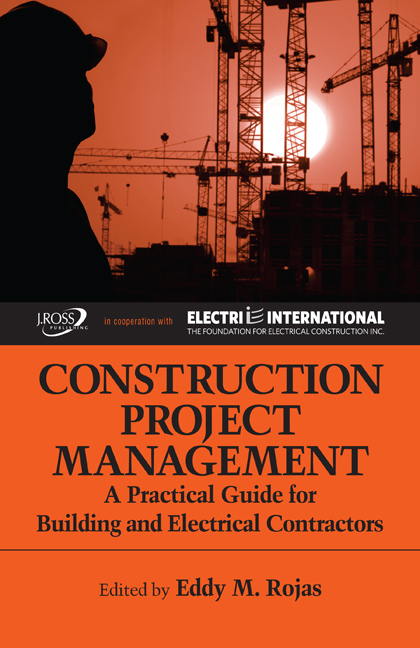Construction Project Management
$49.95
A Practical Guide for Building and Electrical Contractors
Edited by Eddy M. Rojas in Co-operation with ELECTRI International
Hardcover, 6×9, 432 pages
ISBN: 978-1-60427-002-0
June 2009
A Title in J. Ross Publishing’s Strategic Issues in Construction Series
Description
Construction Project Management offers some of the best project management studies commissioned by ELECTRI International: The Foundation for Electrical Construction that were selected, coordinated, and monitored by some of the most progressive contractors and performed by outstanding scholars from top U.S. universities. Topics include pre-construction planning, early warning signs of project distress, impact of change orders, project sequencing, ideal jobsite inventory levels, tool and material control systems, recommended safety practices, partnering, total quality management, quality assurance, performance evaluations, and contract risk management. All specialty and general contractors will find value in this practical book. The concepts presented will improve your understanding of the main issues affecting construction project management and will provide you with tools and strategies to enhance your company’s productivity and profitability.
WAV offers downloadable files consisting of:
- Checklists for each one of the 10 categories that make up the model pre-construction planning process, including standard procedures for change orders, RFIs, submittals, transmittals, billing, progress updates, a sample requirements and expectations letter and a sample letter of intent.
- A Spanish translation of Chapter 7: Recommended Safety Practices.
- A methodology for assessing contractors’ TQM program progress based on the Malcolm Baldrige National Quality Award Criteria.
- Materials to assist contractors in preparing a quality assurance manual and implementing an effective quality assurance program.
- A template for a partnering workshop that includes a sample partnering agenda, an introduction to the basic partnering concepts, sample mission statements, and a sample partnering charter.
- Sample evaluation forms that contractors can customize to evaluate supervisors, journeymen, and apprentices.
Key Features
- Presents construction project management concepts in a clear and understandable manner
- Provides practical information on pre-construction activities to enhance field productivity for construction projects
- Offers specific examples based on real life experience in electrical construction
- Covers major industry issues such as the impact of change orders, safety, tools and material control, and contract risk management
- Presents strategies for implementing concepts such as partnering, total quality management, and quality assurance at the field level
About the author(s)
Dr. Eddy M. Rojas is Professor of Construction Management at the University of Washington, where he is the Graduate Program Coordinator and the Executive Director of the Pacific Northwest Center for Construction Research and Education. He is an internationally recognized scholar in construction engineering and management. Dr. Rojas has published numerous papers in professional journals and conference proceedings and is also the developer and facilitator of the Virtual Community of Construction Scholars. His research interests are modeling, simulation, and visualization of construction engineering and management processes; engineering education; and construction economics.
Table of Contents
Chapter 1: Pre-Construction Planning
Introduction
Methodology
The Pre-Construction Planning Process
Pre-Construction Planning Activities
The Planning Assessment Process
Conclusions
Chapter 2: Early Warning Signs of Project Distress
Introduction
Project Distress Diary (PDD)
Case Study 1
Case Study 2
Conclusions
Chapter 3: Cumulative Impact of Change Orders
Introduction
Fundamental Concepts
Is Cumulative Impact Real?
Determining Impact
Quantifying Impact
Recommendations
Conclusions
Chapter 4: Sequencing Guidelines
Introduction
Background
Case Studies
Sequencing Guidelines
Rules to Support Sequencing Guidelines
Conclusions
Chapter 5: Ideal Jobsite Inventory Levels
Introduction
Inventory Principles
Developing the Loss Function
Optimal Inventory Levels in Construction
Optimal Material Management Models for Contractors
Sic Step of the Procurement Process
Conclusions
Chapter 6: Tool and Material Control Systems
Introduction
Tool Control Systems
Material Control Systems
Conclusions
Chapter 7: Recommended Safety Practices
Introduction
Safety and the Bottom Line
Causation Theories: Why Do Accidents Occur?
The Problem with Academic Accident Theory
Magnitude of the Safety Issue in the Construction Industry
Methodology
Anecdotal Experiences: Recommended Practices
Safety Program Analysis
Conclusions
Chapter 8: Total Quality Management
Introduction
Fundamentals of Total Quality Management
What is Quality?
Committing to Quality
Planning for Quality
Organizing for Quality
Managing for Quality
Identifying Improvement Opportunities
Implementing TQM in the Field
Measuring Results
Conclusions
Chapter 9: Quality Assurance
Introduction
Quality Assurance Fundamentals
Quality Assurance Program Model
Steps in Developing a Quality Assurance Program
Installation, Inspection, and Testing Procedures
Forms, Tags, Checklists, and Records
Evaluating Your Quality Assurance Program
Conclusions
Chapter 10: Partnering
Introduction
Partnering Fundamentals
Benefits of Partnering
Partnering Applications
Recommended Steps for Implementation
Conclusions
Chapter 11: Performance Evaluations
Introduction
Methodology
The Purpose of Performance Evaluations
Survey of Supervisors’ Duties and Attributes
Survey of Craftsmen’s Duties and Attributes
Evaluation Process Details
Conducting Evaluations
Conclusions
Chapter 12: Contract Risk Management
Introduction
Preparing for Contract Risk Management
Rights and Responsibility Clauses
Entitlement Clauses
Procedural Clauses
Conclusions
Appendix: Bibliography
Index
Related products
-
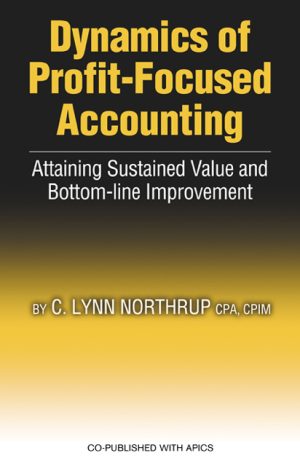
Dynamics of Profit-Focused Accounting
Retail Price: $54.95$44.95 Add to cart -
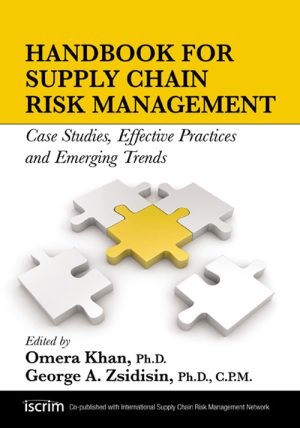
Handbook for Supply Chain Risk Management
Retail Price: $79.95$69.95 Add to cart -
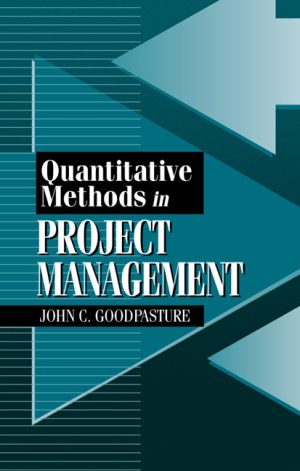
Quantitative Methods in Project Management
Retail Price: $64.95$59.95 Add to cart -
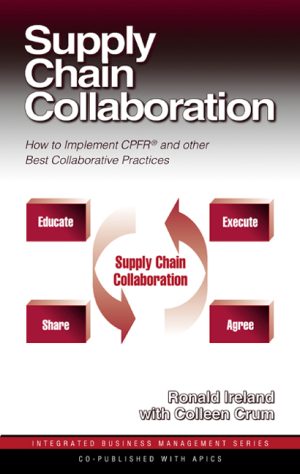
Supply Chain Collaboration
Retail Price: $54.95$49.95 Add to cart -

The Networked Supply Chain
Retail Price: $54.95$44.95 Add to cart

